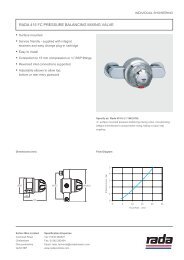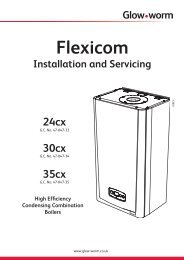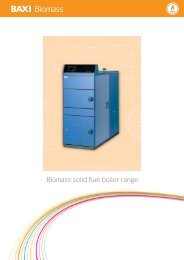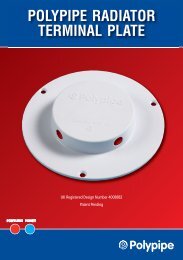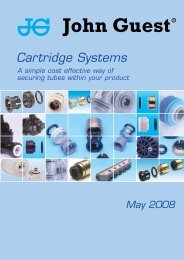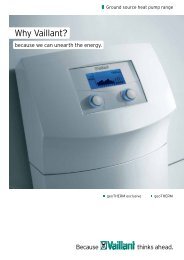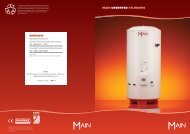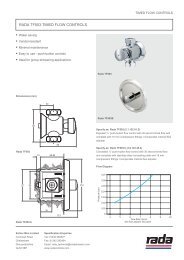Hep20 Technical Handbook
Hep20 Technical Handbook
Hep20 Technical Handbook
You also want an ePaper? Increase the reach of your titles
YUMPU automatically turns print PDFs into web optimized ePapers that Google loves.
Hep 2<br />
O ® Design Considerations<br />
Systems Planning<br />
Hep 2 O ® Pipe Supports<br />
The Hep 2 O ® system includes two<br />
types of pipe clip, the screw fix type<br />
(HX85) and the nail type (HX65).<br />
The nail type is primarily designed<br />
for use on concealed pipework, and<br />
allows for rapid fixing to timber. The<br />
screw type may be used together<br />
with a spacer (HX86) which allows a<br />
greater spacing between the pipe and<br />
the fixing background. The spacer<br />
therefore allows different pipe fixing<br />
centres which can be used to<br />
facilitate pipe cross-overs or the<br />
installation of thermal insulation to<br />
the pipe (see Figure 19 and Table 13).<br />
CL<br />
Pipe Clip<br />
A<br />
Figure 19<br />
Pipe fixing centres<br />
CL<br />
Pipe Clip<br />
and Spacer<br />
Table 13 Pipe Fixing Centres<br />
Nominal dia (mm) 15 22 28<br />
A (mm) 17 21 24<br />
B (mm) 40 43 46<br />
A cold forming bend fixture (HX75)<br />
is available to allow the formation of<br />
a bend on 15mm and 22mm pipes<br />
for situations where secure fixing<br />
and neatness are important. Refer<br />
to Performance Data page 42 for<br />
the minimum radii that can be<br />
achieved.<br />
The recommended support<br />
distances for general purpose use<br />
are shown in Table 14.<br />
Table 14 Recommended Clipping<br />
Distances<br />
Nominal dia (mm) 10 15 22 28<br />
Horizontal runs (m) 0.3 0.3 0.5 0.8<br />
Vertical runs (m) 0.5 0.5 0.8 1.0<br />
B<br />
Where piping is adequately<br />
supported or is run within concealed<br />
spaces (eg. through suspended<br />
timber floors) clips can be reduced<br />
or omitted provided that:<br />
•<br />
the pipe does not form part of<br />
an open vent provided for safe<br />
operation of heat source<br />
•<br />
the pipe does not form a<br />
distribution pipe or circuit where<br />
effective air venting might be<br />
impaired by poor pipe alignment<br />
•<br />
the hot pipe will not touch a cold<br />
pipe or vice versa<br />
•<br />
there is no risk that pipes or<br />
fittings will come in contact with<br />
sharp, abrasive or other<br />
potentially damaging surfaces<br />
•<br />
there is no risk the pipe will come<br />
in contact with materials which<br />
may suffer damage or discoloration<br />
from transmitted heat.<br />
For improved visual appearance<br />
support distances of 300mm are<br />
suggested for Hep 2 O ® in exposed<br />
locations.<br />
Where the pipe is concealed,<br />
clipping may not be considered<br />
necessary. Cable ties may be used<br />
for restraint.<br />
The cabling ability of Hep 2 O ®<br />
enables easy installation through<br />
noggins, studs etc., and in internal<br />
plasterboard/studding walls. Simply<br />
carried out, with tails left exposed<br />
prior to the plasterboard being<br />
installed, this is especially useful for<br />
‘microbore’ plumbing (see page 67).<br />
Partition systems on the market<br />
have the built-in facility for cabling<br />
electrical wiring and this can be<br />
utilised for Hep 2 O ® pipework.<br />
Hep 2 O ® pipe can be easily<br />
manipulated by hand to form<br />
unsupported bends of any angle. In<br />
order to prevent any long term<br />
detrimental effect on the material,<br />
the curvature of Hep 2 O ® pipe<br />
should be not less than the<br />
minimum radii shown in<br />
Performance Data page 42.<br />
Pipe Clip - Nail Type (cable)<br />
Pipe Clip - Screw Type<br />
Pipe Clip Spacer<br />
66



